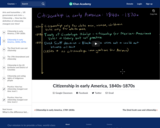
An overview of Citizenship in early America, 1840s-1870s. Created by Kimberly Kutz.
- Subject:
- Political Science
- Social Science
- Material Type:
- Lesson
- Provider:
- Khan Academy
- Provider Set:
- Khan Academy
- Author:
- Kim Kutz
- Date Added:
- 07/16/2021

An overview of Citizenship in early America, 1840s-1870s. Created by Kimberly Kutz.

What is the citizenship status of people who live in the US territories and District of Columbia? Created by Kimberly Kutz.

Definition and examples of civic engagement. Created by Kimberly Kutz.

An overview of Civic life, private life, politics, and government. Created by Kimberly Kutz.

An overview of Civil society. Created by Kimberly Kutz.

Columbus's voyage connected the Americas, Europe, and Africa in a web of exchange that transformed the environments of the Old World and the New World.

In this video, Kim discusses how mutual misunderstandings between Europeans and Native Americans often defined the early years of interaction and trade as each group sought to make sense of the other.

The Civil War is often considered the most transformative event in US history. But how much did it really change American national identity? In this video, Kim compares the relative significance of the effects of the Civil War on American values.

The outcomes in US Congressional elections are affected by the incumbency advantage phenomenon, open and closed primaries, caucuses, and general elections.

When Columbus arrived in the Caribbean, he met the Taino people. In this video, Kim explores the consequences of Columbus's voyage for the Taino people, as well as the changes wrought in Europe by Spain's New World exploits.

In 1787, the Framers of the US Constitution came together to create a stronger central government. In this video, Kim discusses how the Framers compromised over the plan for the legislative branch of government, combining the Virginia Plan and New Jersey Plan to form the House of Representatives and the Senate.

In 1787, the Framers of the US Constitution came together to create a stronger central government. In this video, Kim discusses how the Framers compromised over the plan for the legislative branch of government, combining the Virginia Plan and New Jersey Plan to form the House of Representatives and the Senate.

During the Constitution Convention, the Framers made several compromises, including the method for counting enslaved Africans for the purposes of population (the Three-Fifths Compromise) and the end of the international slave trade.

How revolutionary was the American Revolution? In this video, Kim models the historical thinking skill of continuity and change by comparing society before and after the Revolutionary War.

How much change did industrialization really bring during the Gilded Age? In this video, Kim discusses the impact of industrialization on work, migration patterns, and culture.

How much did the events of the tumultuous postwar era reshape American national identity? Kim discusses the extent to which developments like the Cold War, the Civil Rights Movement, Vietnam, and student protests of the 1960s changed core beliefs around citizenship, cultural values, and the proper US role in the world.

"We hold these truths to be self-evident, that all men are created equal . . . " In this video, Kim explores the origins of the Declaration of Independence in the ideas of Enlightenment philosopher John Locke and its resounding message in history.

How British were the British colonies in North America in 1754? In this video, Kim discusses how the British colonies participated in political, social, cultural, and economic exchanges with Great Britain that encouraged both stronger bonds with Britain and resistance to Britain’s control.

From 1800 to 1848, the United States grew tremendously as a country, adding new territory and building national connections of business and transportation. But just twelve years later, the Civil War erupted! In this period, was the United States developing a unified national identity or a divided regional identity?

How did the Dred Scott case change citizenship in the United States? Created by Kimberly Kutz.